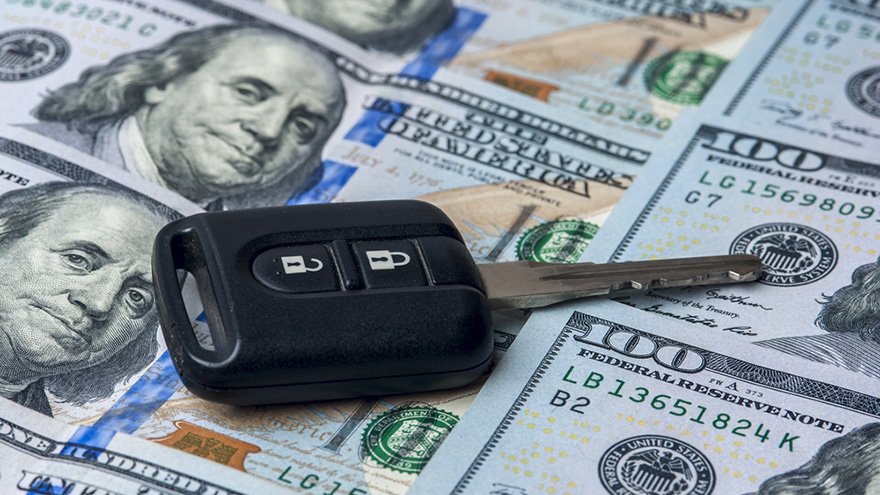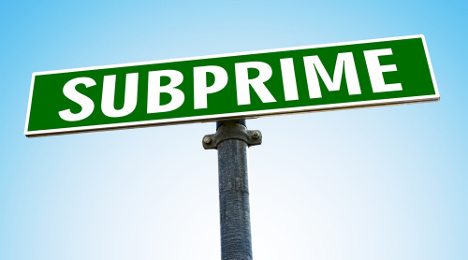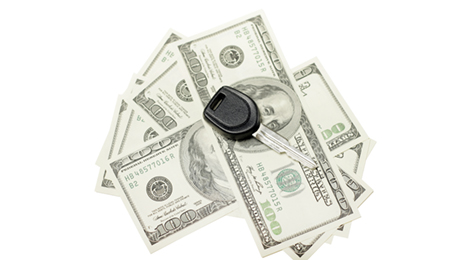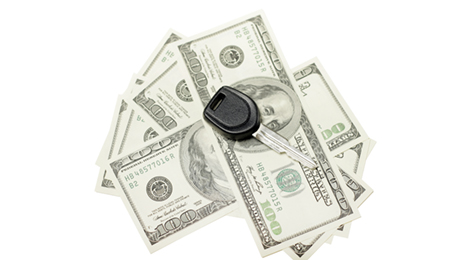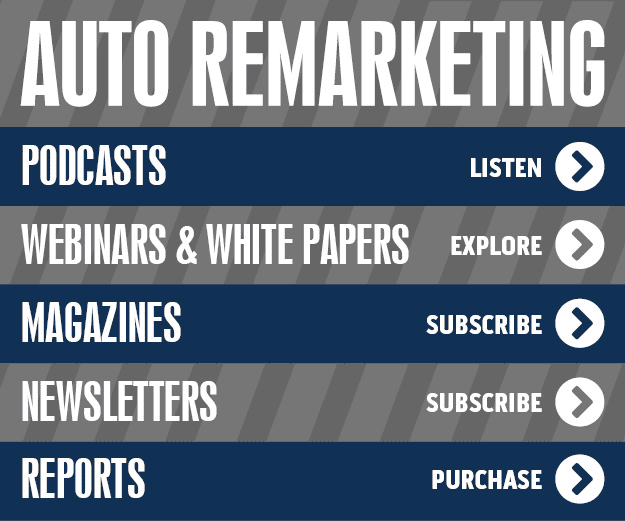The analyst team at S&P Global Ratings asked a question that perhaps many other finance company leaders and auto finance observers have pondered. In fact, the question turned into the title of the firm’s latest report, “After Two Decades On The Road, What’s Driving Rating Stability In Subprime Auto Loan ABS?”
S&P Global Ratings acknowledged there are several factors “sounding alarm bells” within the subprime ABS market. The report began by explaining that S&P Global Ratings’ vintage data for subprime auto loan asset-backed securities (ABS) issued in 2015 and 2016 have shown that delinquencies are rising, meaning borrowers are missing payments even though the unemployment rate is at its lowest level since 2001.
At the same time, the report noted that recoveries have worsened because vehicle values are declining. In 2015 and 2016, S&P Global Ratings said that issuers also included more deep subprime auto installment contacts — individuals with lower and no FICO scores — in their securitizations than in the past.
Analysts then acknowledged that all of these factors have combined, and as a result, loss rates for S&P Global Ratings' subprime auto loan ABS static index are rising and matching levels reported during the 2007-2009 recession. With just under two years of performance, the 2015 vintage at month 21 has cumulative net losses of 8.8 percent — a 19-percent increase from 7.4 percent for the 2014 vintage and in line with 8.9 percent for the 2007 vintage at the same point.
So why aren’t those alarm bells so loud that finance companies can’t hear anything else? Especially since the Federal Reserve said outstanding auto finance balances reached $1.19 trillion in the second quarter?
Analysts pointed out that of that amount outstanding only $100 billion backs S&P Global Ratings-rated retail auto loan ABS.
And while the Fed estimates that $119 billion in subprime auto loans was written in 2016, analysts estimated that only about 19 percent of that paper was securitized, “indicating that portfolio lenders hold a large portion of the exposure,” according to the report.
That report goes on to mention how vibrant capital markets, origination growth and new-vehicle sales all have helped to revive growth in the subprime auto finance market since 2009, demonstrating that the market follows the economic cycle.
Analysts added that the subprime auto loan ABS market has weathered two downturns over the past two decades, and it has since evolved.
Additionally, S&P Global Ratings insisted that subprime auto loan ABS transactions' high credit enhancement levels and other structural features have supported stable ratings. Since 1991, there have been only two defaults on S&P Global Ratings-rated subprime auto loan ABS (both on “BB” rated subordinated classes), and from 2004 through Aug. 31 of this year, there have been 881 upgrades and no defaults or downgrades.
“And while the subprime auto lending sector currently faces a number of headwinds, including intense competition, lower recovery rates, a shifting macro environment, and increased regulatory scrutiny from federal and state agencies, we believe our rating analyses address these risks,” analysts said.
“In our view, certain subprime auto loan ABS securitizers have started to take corrective measures to stem the rise in losses and address heightened risks,” they went on to say.
Westlake Financial Services and Prestige Financial Services each announced updates about securitizations this week, combining for a total surpassing $1.1 billion.
The larger of the two securitizations came from Westlake, which actually rolled out its largest issuance in company history.
Westlake issued an $800 million asset-backed securitization (WLAKE 2017-2) backed by approximately $860 million of automotive paper.
The transaction was led by Wells Fargo Securities (structurer), Credit Suisse and SMBC Nikko. It is the latest of Westlake’s 14 securitizations, which have been comprised of approximately $5.86 billion in cumulative note sales.
“This ABS trumps the most recent securitization completed back in March, which was at the time, our largest ABS ever issued of $700 million,” Westlake chief financial officer Paul Kerwin said. “Our credit performance remains strong in spite of competitive and economic pressures, which attracts investors to our portfolio and enables us to continually increase our securitization amount.”
The company indicated Westlake’s largest-ever securitization has an expected annualized cost of 2.65 percent including the initial purchaser’s fees, which is in-line with prior ABS deals, despite higher benchmark interest rates.
“Westlake’s ABS continue to perform and investors keep supporting our portfolio,” Westlake associate vice president of finance Sean Morgan. “We increased our deal by $100 million with 37 investors on WLAKE 2017-2, which is a reflection of continuous investor demand for Westlake’s ABS.”
Westlake pointed out that it maintains six borrowing facilities funded by 10 banks with combined capacity of $1.48 billion to support continued growth in its full-spectrum financing platform.
Westlake also highlighted that it continues to experience increased growth through its nationwide network of dealers. The company is active in all 50 states, including Puerto Rico, with a dealer base of more than 25,000 franchise and independent dealerships.
Westlake’s current portfolio of $4.01 billion includes originated auto loans, portfolio purchases and dealer flooring lines.
Meanwhile over at Prestige Financial Services, the announced it has completed its 16th rated term securitization, issuing $335,223,000 in securities backed by $358,533,598 in automobile installment receivables.
In a transaction led jointly by J.P. Morgan Securities and Wells Fargo Securities, Prestige indicated that notes were purchased by qualified institutional buyers in a private offering pursuant to Rule 144A of the Securities Act. The securitization closed on Wednesday.
Officials highlighted the seven note classes issued by Prestige Auto Receivables Trust 2017-1 carried ratings ranging from A-1+/R-1(h) through BB/BB from Standard & Poor’s and DBRS, respectively, based on several factors including Prestige’s track record as a loan originator and servicer. The duration-weighted average rate was 2.76 percent.
“Prestige has been an active participant in the asset-backed term market for two decades, with nearly $4 billion in total issuance,” J.P. Morgan Securities executive director Billy Wong said. “PART 2017-1 is yet another demonstration of the company’s ability to access liquidity on relatively favorable terms.”
Prestige was founded in 1994 as an affiliate of the Larry H. Miller Group of Companies, which includes the NBA’s Utah Jazz and one of the country’s largest dealership networks. Today, Prestige manages a portfolio of more than $1 billion in contracts and does business with dealerships across the country.
“Our securitizations have continued to enjoy the support of both new and repeat investors,” Prestige chief financial officer Aaron Dalton said. “Thanks to them, this transaction delivered some of our tightest pricing spreads ever.”
Prestige added that all notes included in this transaction having been sold, and this announcement appears as a matter of record only.
Despite four factors that might make its confidence deteriorate, Kroll Bond Rating Agency (KBRA) said in a report released on Monday that it remains “comfortable” with auto loan ABS fundamentals.
That assertion came within the firm’s newest structured finance research report titled, "U.S. Auto Market Update: Deconstructing Headline Loss Rates." Before making a trio of additional assertions, KBRA acknowledged delinquency and net loss rates for the securitization of auto paper have been rising.
Analysts pointed out that peak losses in prime and non-prime collateral pools reached 0.94 percent and 9.43 percent earlier this year, respectively, versus 0.79 percent and 8.23 percent a year ago.
KBRA also conceded that there multiple late-cycle indicators continuing to garner headlines — softer used-vehicle pricing, rising inventories, weakening seasonally adjusted annual sales (SAAR) and rising loan losses. Nonetheless, analysts arrived at its “comfortable” position while making these conclusions:
—Much of the deterioration in auto loan ABS fundamentals can be attributed to mix shift. However, as the used-vehicle market has softened, the firm has seen incremental deterioration on an issuer-by-issuer basis.
—Analysts think used-vehicle prices remain vulnerable to a confluence of factors, including excess OEM production and dealer inventory, elevated new-model price incentives and growing off-lease vehicle supply. KBRA’s expectation is for continued softening in the used-vehicle market through 2017 and 2018, which will likely continue to place pressure on auto loan loss rates as severities remain elevated.
—Despite rising losses, KBRA insisted risks remain well contained, and investors are well protected given that these securitizations continue to benefit from robust credit protection.
With average vehicle installment contract terms nearly at 70 months and outstanding auto asset backed security issuance at the highest level in 14 years, the latest update from Fitch Ratings also pinpointed where the weakest vintage in subprime financing appears to be.
Fitch’s Hylton Heard and John Bella Jr. explained in a report delivered to SubPrime Auto Finance News that 2015 is the weakest vintage in the subprime space. Heard and Bella arrived at that assertion since contracts in that vintage now are seasoned 19 months, and the 2015 vintage is extrapolating to more than 15 percent in cumulative net losses. That figure is higher than any vintage since 2005, according to Fitch’s report.
“The 2015 vintage has been prone to high loss severity from a weaker wholesale market and little-to-no equity in loan contracts at default due to extended-term lending, a trend that was not as apparent in the recessionary vintages,” Heard and Bella said in the report.
Meanwhile, Fitch noticed the 2016 vintage is showing some improvement. Although only seasoned six months, Fitch reported the 2016 vintage is performing slightly better than the 2015 vintage, but loss extrapolations still show losses reaching a range of 13 percent to 14 percent.
Overall, Fitch found that vintages from 2014 through 2016 are trending in line with ones seen during recessionary times, as the span from 2009 through 2012 produced losses between 8 percent and 11 percent and the 2013 segment came in at 11.5 percent.
As previously mentioned, Fitch pointed out that contract terms averaged above 69 months during the first half of the year.
“Lenders have offered higher terms in response to lower new vehicle sales and rising vehicle transaction prices, supporting consumers in purchasing a vehicle,” Heard and Bella said in the report.
With consumers taking on more debt load to obtain a vehicle, the auto ABS issuance is soaring, too. Fitch determined outstanding prime and subprime auto loan ABS hit $102.2 billion through the first half of this year; the highest level recorded in more than 14 years.
More details about subprime market
Fitch’s Heard and Bella acknowledged “both delinquencies and losses have come down from peaks levels experienced in prior months as consumers benefited from tax season during 2Q17.” But 60-day delinquencies closed the quarter at 4.55 percent, which marked a rise of 12 percent year-over-year.
The report also mentioned annualized net losses in the subprime segment jumped 17.4 percent year-over-year in the second quarter to come in at 7.42 percent.
“In addition to higher loss frequency, recovery rates have continued to decline due to wholesale market weakness, further contributing to elevated loss levels,” Heard and Bella said in the report.
Fitch’s report mentioned the ABS platforms from Santander Consumer USA and GM Financial continued to exhibit “stable performance despite slightly higher delinquencies and losses.
“Loss levels for transactions from both platforms remained well within Fitch’s initial base case loss expectations,” Heard and Bella said.
“Non-established ABS platforms continued to drive much of the weaker performance observed in the subprime ABS sector. Many of these platforms have limited experience and have issued ABS secured by loans with high LTVs and high term to deeper subprime borrowers,” continued Heard and Bella, who mentioned that these non-established platforms now account for 50 percent of Fitch’s subprime index, “well above historical levels.”
Meanwhile, the volume of paper potentially going into the subprime ABS market is diminishing.
“Fitch observed a notable pullback in origination volume from certain subprime lenders, particularly larger ones, in 2016, a trend that has continued in (the first half of 2017). Fitch views these pullbacks as a positive, and performance may improve should lenders employ stricter underwriting criteria,” Heard and Bella said in the report.
Update on prime market
According to Fitch’s report, prime auto ABS performance has stabilized so far this year, “in line with seasonal trends; however, 12-month averages continued to climb.”
The report noted that 60-day delinquencies in the prime segment decline to 0.37 percent from 0.42 percent a year earlier. Despite the improvement, Fitch found that the trailing 12-month average has reached 0.42 percent, the highest level in five years.
While prime annualized net losses decreased to 0.54 percent at the year’s midpoint, Fitch calculated that the figure represented a 15-percent jump compared to the same point a year ago.
“Prime loan ABS credit quality continues to be stable to improving as a result of tighter underwriting from a FICO perspective. This is in direct response to elevated loss levels, particularly for lower FICO borrowers, and is a positive for asset performance,” Heard and Bella said in the report.
“Average contract balances continues to increase driven by increasing sales of utility vehicles and higher MSRPs overall,” they continued. “The term continues to be extended in an effort to keep payments manageable for borrowers, but asset performance for extended term loans is generally weaker and has been a driver of weaker recovery rates observed recently.
"This dynamic will continue to affect loss severity, particularly for early-stage defaults,” Heard and Bella went on to say.
S&P Global Ratings noticed a stark difference between the prime and subprime segments when examining collateral performance in May within U.S. auto loan asset-backed securities (ABS).
Analysts reviewed the May data and found that in prime segment, relative to April, losses decreased slightly while delinquencies held stable. On a year-over-year basis, however, prime losses and delinquencies rose despite recoveries improving.
For subprime, S&P Global Ratings determined all three metrics — losses, recoveries and delinquencies — worsened both month-over-month and year-over-year.
According to an S&P Global Ratings report published this week, prime net losses decreased month over month to 0.53 percent in May from 0.56 percent in April and increased year-over-year from 0.43 percent. The firm explained that much of the 23 percent year-over-year uptick in losses is due to California Republic Bank’s and TCF’s issuances becoming a slightly larger share of the prime index and their 2015, as well as 2016, securitizations experiencing weaker performance than their 2014 deals.
“We’re also seeing higher losses for some captive finance entities on their 2016 transactions,” analysts added.
The subprime net loss rate increased to 6.43 percent in May from 6.14 percent in April and 5.00 percent in May of last year.
As a supplement to its subprime index, S&P Global Ratings created the modified subprime index, which excludes certain high-loss deep subprime issuers (Drive Auto Receivables Trust, American Credit Acceptance and Exeter Automobile Receivables Trust. On a month-over-month basis, the modified subprime loss rate increased to 5.29 percent in May from 4.98 percent in April and 4.63 percent in May 2016.
The tracker also monitors performance on a securitization vintage basis.
Cumulative net losses on the 2015 prime Auto Loan Static Index are at 0.57 percent through month 18, a 32-percent increase over 2014’s losses of 0.43 percent. Through month six, the 2016 vintage is reporting higher losses than the 2010-2015 cohorts at the same point.
Cumulative net losses on the 2015 subprime Auto Loan Static Index are at 8.0 percent through month 19, a 19-percent jump over 2014’s losses of 6.70 percent.
“Most of the deterioration is due to Santander securitizing deep subprime auto loans beginning in 2015 via its DRIVE shelf,” analysts said. “These deals have an average cumulative net losses of approximately 12 percent through month 19, and given that they represent 24 percent of the collateral in our 2015 subprime index, they are pulling up the index's losses.
Our modified index, which excludes DRIVE, ACA and Exeter, indicates that without these three cumulative net losses through month 19 would drop to 5.78 percent from 8.0 percent, putting performance in line with 2012’s and 2013’s performance,” analysts continued.
S&P Global Ratings also mentioned cumulative net losses through month 6 for the 2016 subprime vintage are trending higher than the 2010-2015 vintages at the same point, “again in large part due to the composition of the index.”
During the first six months of this year, S&P Global Ratings upgraded 139 auto loan ABS tranches, affirmed 151 and downgraded none. Of the 139 upgraded, 99 were in subprime.
“Despite losses trending slightly higher than our original expectations on some of these transactions, credit enhancement as a percentage of the outstanding collateral amount has grown since the transactions’ closings and has provided support for the elevated ratings,” analysts said.
With the firm also seeing captive finance companies likely to face continued pressure on profitability, Fitch Ratings noticed a wide array of headwinds impacting the auto ABS market, too.
However, Fitch is keeping its rating outlook as stable, according to its latest U.S. Auto ABS Index Report.
“Despite negative headlines in the auto sector, including weaker used values, Fitch Ratings continues to issue prime and subprime upgrades in 2017 given asset performance within or better than our forecasts,” Fitch’s Hylton Heard and John Bella Jr. said in the report shared with SubPrime Auto Finance News.
Looking deeper at the subprime sector, Fitch indicated annualized net losses reached 10.42 percent in February, almost hitting the segment high of 10.92 percent set in November.
“Tax refunds kicked in and losses declined through March but were 5.1 percent higher than in 2016,” Heard and Bella said.
“Fitch does not rate most of the smaller ABS platforms, but they are driving the (annualized net loss) index higher, particularly given the increase composition in the index versus three to four years ago,” said Heard and Bella, adding that securitizations from finance companies such as Santander Consumer USA and GM Financial previously had constituted the majority of their analysis. Now those two issuers make up only about 50 percent of their analysis pool as the other newcomers represent “well above historical levels.”
Heard and Bella continued by saying, “Despite a lot of positive economic factors, smaller lenders who rely heavily on ABS for funding could face financial issues were their portfolios continuing to underperform in 2017.”
Heard and Bella also noticed that some subprime finance companies are not originating as much paper as they previously had, prompting the Fitch experts to note in the report that “signs of pullback in lending a positive.”
They continued with, “It is a good sign that a number of large auto lenders/ABS issuers have tightened lending standards and retail volumes have declined, as sales declined moderately.”
Heard and Bella added, “The largest driver of weaker collateral underwriting is the high level of competition for lending over the past five years with interest rates low and lack of access to traditional bank lending for subprime borrowers.
“Lenders have begun tightening underwriting in response to weakening asset performance observed in 2016,” they went on to say in the report. “Fitch is observing some improvements in average credit quality of borrowers in ABS pools brought to market in 2017 and expects this trend will continue. However, longer term loans continued to represent an increased portion of originations, which may continue to pressure recoveries for early stage defaults.”
The Fitch experts still are keeping their ABS outlook as stable despite one other factor pointed out in the report — acknowledging that used-vehicle values are under pressure. They noted the Black Book Value Retention Index declined to 115.9 through March, a 6 percent year-over-year softening.
“Creeping default/repo volumes, along with very high lease returns, are affecting used values. New-vehicle days’ supply have crept higher and sales dipped, while incentives are at record levels, all negatives for wholesale values,” Heard and Bella said.
Captives under pressure, too
In a separate report, Fitch Ratings determined captive finance companies are likely to face continued pressure on profitability due to rising credit losses, declining residual values and higher funding costs. The firm made that assertion according to a review of U.S. captive finance companies from Fitch Ratings.
In addition, after a solid 2016, portfolio growth is likely to moderate over the near term, particularly for consumer-oriented companies, as U.S. auto sales are expected to decline. Average portfolio growth for the captives in this report was 4.5 percent in 2016, up slightly from 3.9 percent in 2015.
Analysts indicated average pretax earnings margins were 23 percent in 2016, down from 29 percent in the prior year, due primarily to weakening asset quality, declines in used vehicle prices, and competitive pressure on asset yields.
"Weaker credit performance is likely to continue in 2017, with both charge-offs and delinquencies climbing from historically low levels as a result of portfolio seasoning and lower recovery rates on defaulted auto loans," said Michael Taiano, director at Fitch Ratings.
The review also showed overall credit quality for consumer and commercial captives in 2016 continued to weaken, which was consistent with Fitch's expectations following post-crisis lows that were unsustainable. Average net loss rates for the captives included in this report increased “meaningfully” to 0.82 percent in 2016 from 0.61 percent in 2015. The increase in net credit losses was most pronounced within the auto captive segment.
Fitch also noted leverage has been on the rise for several captives.
Analysts found that the average leverage for the group ticked up slightly at the close of 2016 to 7.5 times versus 7.4 times in 2015, with many captives currently at or near five-year averages. Fitch explained that captive leverage, as measured by debt to tangible equity, is typically higher relative to many stand-alone finance companies in part due to explicit or implicit parent support.
The firm added that the willingness of parent companies to inject capital and/or reduce/forgo dividends to support asset growth has limited further increases in leverage. Fitch expects U.S. captive portfolio growth to moderate in 2017, which should limit further increases in leverage for most, absent material credit deterioration.
“The slight increase in leverage reflects stronger portfolio growth relative to more moderate earnings growth,” Taiano said.
S&P Global Ratings reported that collateral performance in the U.S. prime and subprime auto loan asset-backed securities (ABS) sectors was mixed in April relative to March. Analysts indicated that while losses and recoveries continued to show seasonal improvement on a month-over-month basis, delinquencies rose.
According to a report published by S&P Global Ratings, the prime 60-plus-day delinquency rate increased to 0.43 percent in April from 0.41 percent in March and increased from 0.35 percent in April of last year. The subprime 60-plus-day delinquency rate also increased to 3.85 percent in April from 3.57 percent in March 2017 and from 3.38 percent in the same month last year.
The firm pointed out its modified subprime 60-plus-day delinquency rate — which excludes certain high-loss deep subprime issuers — increased to 2.93 percent in April from 2.74 percent in March and ticked up from 2.69 percent versus last April.
Due to the monthly increase in delinquencies, we expect losses to rise on a month-over-month basis now that the tax refund season has ended,” analysts said.
While prime and subprime losses and recoveries improved on a month-over-month basis due to seasonal factors, namely tax receipts, losses increased and recoveries weakened year over year for both sectors,” they continued.
In S&P Global Ratings' view, declining used vehicle values, which are partly due to the increase in off-lease vehicles, have led to lower recovery rates. In addition, the firm noted recovery rates have been affected by longer loan terms and higher loan-to-value (LTV) ratios.
Lower used-vehicle values are having a greater impact on the subprime sector because it has a higher level of repossessions,” analysts said.
“Another contributing factor may be the mix of vehicles in subprime pools, which tend to be skewed toward more affordable cars,” they continued. Crossovers and trucks, which make up a greater share of many prime pools, are maintaining their values better in the low gas price environment.”
The automotive segment helped to push asset-backed securities issuance in May to the second-most active month of the year, according to the latest update from S&P Global Ratings.
Analysts reported that total ABS issuance during May came in at $23 billion, bringing the year-to-date volume to $102 billion.
S&P Global Ratings noticed that May was supported once again by a heavy auto ABS issuance that reached over $10 billion, the second-highest monthly volume this year.
The update also mentioned that auto-related issuance now stands at $45 billion through the first five months of the year.
Analysts considered whether acceleration of issuance is being supported by what some experts might call “ideal market conditions.” S&P Global Ratings stopped short of that description.
“It is difficult to say what has been driving increased issuance in 2017,” analysts said. “Conditions have reportedly been ideal with tight spreads offering attractive financing levels for issuers. Rates are expected to increase, which may be driving some ABS issuers to move more assets off their balance sheets to free up capacity.
“Overall interest rates have remained relatively low and attractive to borrowers that currently have low debt service obligation,” they continued. “Prorating 2017 issuance so far would create more than $460 billion of issuance, but it is still difficult to say how much longer these ideal market conditions will continue.”
S&P Global Ratings confirmed that typical seasonal impacts helped collateral performance in the U.S. prime and subprime auto loan asset-backed securities (ABS) sectors to improve in March relative to February.
Analysts indicated in their latest report that losses, delinquencies and recoveries performed better month-over-month due to seasonal trends, including consumers using tax refunds to catch up on their payment obligations.
“Tax refunds also created demand for used vehicles, thereby bolstering recovery rates on a month-over-month basis,” S&P Global Ratings said.
“On a year-over-year basis, the prime sector continued to post weaker loss, delinquency and recovery results,” the firm continued. “Meanwhile, the subprime segment demonstrated year-over-year stability in losses, but recovery rates continued to worsen and delinquencies rose slightly."
According to a report published by S&P Global Ratings, prime net losses decreased month-over-month to 0.63 percent in March from 0.73 percent in February.
However the reading increased year-over-year from 0.40 percent.
“Prime recoveries are also declining on a year-over-year basis and this is affecting some of the captive finance pools,” analysts said. “Further, some prime issuers have loosened their credit standards for their 2015 and much of their 2016 originations.”
S&P Global Ratings goes on in the report to mention the subprime net loss rate decreased to 6.20 percent in March from 7.51 percent in February. The reading also was nearly stable year-over-year since the level in March 2016 came in at 6.16 percent.
As a supplement to its subprime index, S&P Global Ratings reiterated that it created the modified subprime index, which excludes certain high-loss deep subprime issuers. On a month-over-month basis, analysts noticed the modified subprime losses decreased to 5.33 percent in March from 6.08 percent in February.
But losses in the modified subprime index increased from 4.99 percent in March of last year.
S&P Global Ratings closed its latest ABS discussion by reviewing how loan-to loan-to-value ratios (LTV) are impacting the latest trends.
In reviewing collateral trends for transactions issued in the first quarter of this year, S&P Global Ratings said it observed that the weighted average loan-to-value (LTV) ratio for subprime transactions declined to 110.41 percent from 114.37 percent a year earlier, with six issuers reporting a year-over-year reduction in their weighted average LTV of at least 100 basis points.
“We believe these companies have lowered their LTVs in response to higher losses and the outlook for continued weakness in recovery rates,” analysts said.
The metrics and performance of General Motors Financial are showing more distinct characteristics of a traditional captive finance company and less of a provider that used to book a significant amount of subprime paper.
In fact, GM Financial reported that its penetration of originations associated with retail deliveries by the parent automaker reached an all-time high during the first quarter, climbing to 50.4 percent. The level smashed the previous all-time record established a year earlier, which was 37.5 percent.
“GM had some down payment assistance promotions in the market during the quarter, which drove increased penetration of standard loans,” GM Financial president and chief executive officer Dan Berce said.
However, the company didn’t abandon the subprime space completely. Berce pointed out during the company’s recent quarterly conference call that originations through its AmeriCredit channel — the division that works with non-GM dealers and typically takes the subprime paper — grew to $700 million during the second quarter, up by $200 million year-over-year.
All told, GM Financial reported that its retail originations totaled $6.5 billion for the quarter that ended March 31, compared to $4.7 billion for the quarter that closed Dec. 31 and $4.1 billion for the year-ago quarter.
“Credit trends remained stable, positively impacted by our mix shift to prime credit quality assets in U.S.,” Berce said. “And our primary headwind remains used-car values, U.S. disposition proceeds on returned leased vehicles compared to estimates at origination continued to moderate during the quarter.
“We do expect used vehicle prices to decline about 7 percent year-over-year throughout 2017,” he continued.
GM Financial indicated its outstanding balance of retail finance receivables was $36.0 billion as of March 31.
Chief financial officer and executive vice president Chris Choate explained the subprime segment of the company’s portfolio represented approximately 12 percent of its ending earning assets when the second quarter finished, down from 17 percent a year earlier.
“The composition of those earning assets continues to shift to a more prime light credit profile, consistent with some of the mix trends Dan has already discussed,” Choate said.
That additional prime paper helped to improve other GM Financial metrics.
The company reported its retail finance receivables 31 to 60 days delinquent constituted 2.8 percent of the portfolio at the close of the first quarter. A year earlier, it was 3.1 percent.
GM Financial noted accounts more than 60 days delinquent improved to 1.2 percent of the portfolio from 1.4 percent a year ago.
The company added its annualized net charge-offs remained flat year-over-year, holding at 1.9 percent of average retail finance receivables.
Berce also mentioned recovery rates stood at 52 percent for the quarter, down from 54 percent a year ago. He said the rates were “up a bit sequentially due to seasonal reasons, but we do expect recovery rates to continue to trend down year-over-year throughout 2017.”
Looking more positively, customers maintaining their payments helped GM Financial to post net income of $202 million for the quarter, up from $164 million a year earlier.
A few other notable elements to GM Financial’s Q1 report included the call out of its outstanding balance of commercial finance receivables ticking up to $11.8 billion as of March 31.
The company also highlighted total available liquidity of $12.4 billion as of March 31, consisting of $2.7 billion of cash and cash equivalents, $8.3 billion of borrowing capacity on unpledged eligible assets, $0.4 billion of borrowing capacity on committed unsecured lines of credit and $1.0 billion of borrowing capacity on a Junior Subordinated Revolving Credit Facility from GM.
“Our funding platform continued successful execution on many fronts,” Berce said. “We issued $5.5 billion in public secured and unsecured debt securities in the quarter. And subsequent to quarter end, we closed our first U.S. prime loan securitization, which we call GMCAR, for a total of $1 billion.”
Elaborating about securitizations, Choate later added, “Also, as a reminder, we have numerous securitization platforms segregated by asset type and geography. This list is very similar to a list from prior quarters, with the exception, again, that we have now executed our first U.S. prime retail loan securitization under the GMCAR platform.
“Our global senior notes platform funds our operations in the U.S., Canada, Europe and Mexico, where we expect to do five to eight issuances per year,” Choate went on to say. “And our total issuance in 2017 will be increasing this year, most notably because of the launch of our GMCAR securitization program. Otherwise, we expect our cadence to be reasonably similar to 2016.”

